Infrastructure
End
Fire trucks and other apparatuses are usually large and heavy vehicles. Because safely accelerating and steering requires lots of space and their load sets high demands to the pavement, there must be certain accommodations made for them. By legally mandating erection of fire lanes, authorities can ensure firefighters fast and reliable access to potential sites of emergencies. [3]
Fire lanes also provide clear space for egress from a burning building and should therefore be wider for larger occupancy buildings.
Markings
The following is applicable only to the United States of America
All fire lanes must be marked as such, although the manner of marking may be different.
A fire lane that runs along the center of a street is marked “Fire Lane”.
If the lane is 20 feet (6.1m) across, it must be marked on both sides with red paint on the curb. [4] If the fire lane is between 20 (6.1m) and 24 feet (7.3m), it may only be marked on one side of the roadway. If the access road is greater than 28 feet (8.5m) wide, no markings need to be present.
Fire lanes in front of commercial buildings may have yellow paint to mark the fire lane. The curb should be painted yellow with the words “No Parking, Fire Lane” painted in black. On the pavement, yellow lines should be painted the width of the fire lane, with the words 12 inches (30cm) tall and painted in yellow.
Dimensioning
The following is applicable only to the United States of America
There are certain requirements that must be met when designing a fire lane. These can vary from jurisdiction to jurisdiction, yet they are generally similar.
Fire lanes may be any width larger than 20 feet (6.1m) across. This gives enough room to maneuver the truck into position. They must also be at least ten feet away from any building or structure overhang to allow overhead clearance. If trees are near a fire lane, they must be trimmed to allow a 14-foot (4.25m) clearance over the fire lane. [1] The fire lane must be within 150 feet (45.7) of the ends of the buildings that it serves. If a fire lane goes around a curve or corner, it must have an outside turning radius of 54 feet (16.5m), and an inside turning radius of 30 feet (9m). [1] These numbers can be a little different depending on the jurisdiction, but are usually roughly the same. The fire lanes must also be approved to carry at least 35 imperial tons (22.6 tonnes) of weight. [1]
Furthermore, different standards may apply for operators of airports, harbors or industrial plants.
Dead ends
It is preferable for a fire lane to have access at both ends to a road. If that is not possible and a fire lane must be made into a dead end, a fire lane turnaround is put in. [1] It must be large enough for a fire truck to turn around to head out the same way it came in. They can be made as a large circle, or in the shape of a Y, T or a sideways T. They must be marked with either paint striping, signs, or the use of both. Striping consists of a six-inch red stripe painted on the curb with four-inch white letters indicating that this is a fire lane. “No Parking, Fire Lane” is to be printed every 25 feet (7.62m) along the fire lane.

Traffic comprises pedestrians, vehicles, ridden or herded animals, trains, and other conveyances that use public ways (roads) for travel and transportation.

A pedestrian crossing is a place designated for pedestrians to cross a road, street or avenue. The term "pedestrian crossing" is also used in the Vienna and Geneva Conventions, both of which pertain to road signs and road traffic.

A taxiway is a path for aircraft at an airport connecting runways with aprons, hangars, terminals and other facilities. They mostly have a hard surface such as asphalt or concrete, although smaller general aviation airports sometimes use gravel or grass.

A shoulder, hard shoulder (British) or breakdown lane, is an emergency stopping lane by the verge of a road or motorway, on the right side in countries which drive on the right, and on the left side in countries which drive on the left. Many wider (U.S.) freeways, or expressways elsewhere have shoulders on both sides of each directional carriageway — in the median, as well as at the outer edges of the road, for additional safety. Shoulders are not intended for use by through traffic, although there are exceptions.

In road transport, a lane is part of a roadway that is designated to be used by a single line of vehicles to control and guide drivers and reduce traffic conflicts. Most public roads (highways) have at least two lanes, one for traffic in each direction, separated by lane markings. On multilane roadways and busier two-lane roads, lanes are designated with road surface markings. Major highways often have two multi-lane roadways separated by a median.

An emergency vehicle is a vehicle used by emergency services. Emergency vehicles typically have specialized emergency lighting and vehicle equipment that allow emergency services to reach calls for service in a timely manner, transport equipment and resources, or perform their tasks efficiently. Emergency vehicles are usually operated by authorized government agencies, but some may also be operated by private entities where permitted by law.
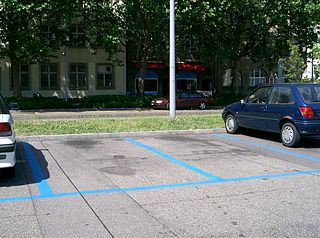
A parking space, parking place or parking spot is a location that is designated for parking, either paved or unpaved. It can be in a parking garage, in a parking lot or on a city street. The space may be delineated by road surface markings. The automobile fits inside the space, either by parallel parking, perpendicular parking or angled parking.
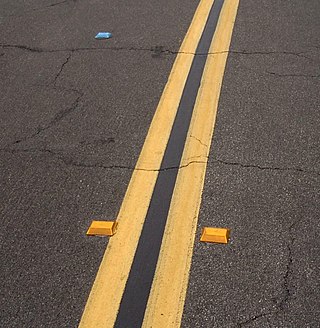
A raised pavement marker is a safety device used on roads. These devices are usually made with plastic, ceramic, thermoplastic paint, glass or occasionally metal, and come in a variety of shapes and colors. Raised reflective markers, such as plastic, ceramic, or metal ones, include a lens or sheeting that enhances their visibility by retroreflecting automotive headlights, while glass road studs gather automotive headlights with a dome shape and reflect the lights with a reflective layer within. Some other names for specific types of raised pavement markers include convex vibration lines, Botts' dots, delineators, cat's eyes, road studs, or road turtles. Sometimes they are simply referred to as "reflectors".

Road surface marking is any kind of device or material that is used on a road surface in order to convey official information; they are commonly placed with road marking machines. They can also be applied in other facilities used by vehicles to mark parking spaces or designate areas for other uses. In some countries and areas, road markings are conceived as horizontal traffic signs, as opposed to vertical traffic signs placed on posts.

Road signs in the United Kingdom and in its associated Crown dependencies and overseas territories conform broadly to European design norms, though a number of signs are unique: direction signs omit European route numbers and road signs generally use the Imperial System of units, unlike the rest of Europe. Signs in Wales and parts of Scotland are bilingual.
A placard is a notice installed in a public place, like a small card, sign, or plaque. It can be attached to or hung from a vehicle or building to indicate information about the vehicle operator or contents of a vehicle or building. It can also refer to paperboard signs or notice carried by picketers or demonstrators.

A curb, or kerb, is the edge where a raised sidewalk or road median/central reservation meets a street or other roadway.
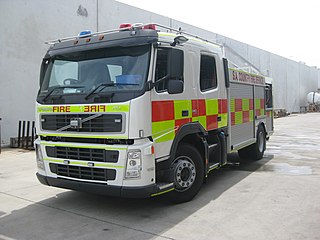
Battenburg markings or Battenberg markings are a pattern of high-visibility markings developed in the United Kingdom in the 1990s and currently seen on many types of emergency service vehicles in the UK, Crown dependencies, British Overseas Territories and several other European countries such as the Czech Republic, Iceland, Sweden, Germany, Romania, Spain, Ireland, and Belgium as well as in New Zealand, Australia, Hong Kong, Trinidad and Tobago, and more recently, Canada. The name comes from its similarity in appearance to the cross-section of a Battenberg cake.
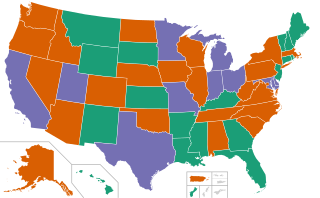
In the United States, road signs are, for the most part, standardized by federal regulations, most notably in the Manual on Uniform Traffic Control Devices (MUTCD) and its companion volume the Standard Highway Signs (SHS).
Traffic signs, installations, and symbols used in Germany are prescribed by the Road Traffic Regulations (StVO) and the Traffic Signs Catalog (VzKat).
Road traffic control devices are markers, signs and signal devices used to inform, guide and control traffic, including pedestrians, motor vehicle drivers and bicyclists. These devices are usually placed adjacent, over or along the highways, roads, traffic facilities and other public areas that require traffic control.
Road signs in Canada may conform to the Manual of Uniform Traffic Control Devices for Canada (MUTCDC) by the Transportation Association of Canada (TAC) for use by Canadian jurisdictions. Although it serves a similar role to the MUTCD from the US Federal Highway Administration, it has been independently developed and has a number of key differences with its American counterpart, most notably the inclusion of bilingual (English/French) signage for jurisdictions such as New Brunswick with significant anglophone and francophone population, and a heavier reliance on symbols rather than text legends.

A firefighting apparatus describes any vehicle that has been customized for use during firefighting operations. These vehicles are highly customized depending on their needs and the duty they will be performing. These duties can include firefighting and emergency medical services.
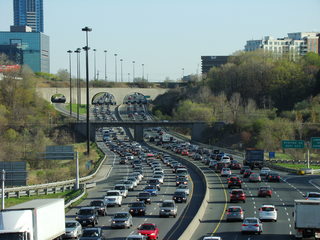
Terminology related to road transport—the transport of passengers or goods on paved routes between places—is diverse, with variation between dialects of English. There may also be regional differences within a single country, and some terms differ based on the side of the road traffic drives on. This glossary is an alphabetical listing of road transport terms.

Yellow lines are road markings used in various territories.

















